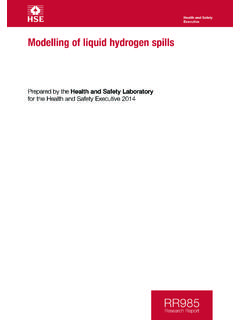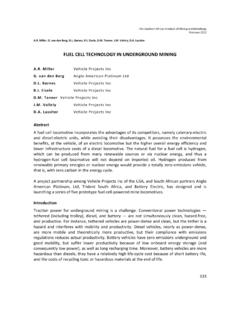Transcription of Hazards of liquid hydrogen - Health and Safety …
1 Executive Health and Safety Hazards of liquid hydrogen Position paper Prepared by the Health and Safety Laboratory for the Health and Safety Executive 2010 RR769 Research Report Executive Health and Safety Hazards of liquid hydrogen Position paper D K Pritchard & W M Rattigan Health and Safety Laboratory Harpur Hill Buxton Derbyshire SK17 9JN In the long term the key to the development of a hydrogen economy is a full infrastructure to support it, which include means for the delivery and storage of hydrogen at the point of use, eg at hydrogen refuelling stations for vehicles. In the meantime as an interim measure to allow the development of refuelling stations and rapid implementation of hydrogen distribution to them, liquid hydrogen (LH2) is considered the most efficient and cost effective means for transport and storage . This will result in increasing amounts of LH2 transported by road, and possibly by rail, and storage of moderately large quantities at refuelling stations, many of which will be in urban areas.
2 Although cryogenic liquid storage has been used safely for many years in secure and regulated industrial sites, its use in relatively congested, highly populated urban areas presents a new set of issues in relation to security, Safety and associated planning. The Health and Safety Executive commissioned the Health and Safety Laboratory to identify and address issues relating to bulk liquid hydrogen transport and storage and update/develop guidance for such facilities. This position paper, the first part of the project, assesses the features of the transport and storage aspects of the refuelling stations that are now being constructed in the UK, compares them to existing guidance, highlights gaps in the regulatory regime and identifies outstanding Safety issues. This report and the work it describes were funded by the Health and Safety Executive (HSE). Its contents, including any opinions and/or conclusions expressed, are those of the authors alone and do not necessarily reflect HSE policy.
3 HSE Books Crown copyright 2010 First published 2010 All rights reserved. No part of this publication may be reproduced, stored in a retrieval system, or transmitted in any form or by any means (electronic, mechanical, photocopying, recording or otherwise) without the prior written permission of the copyright owner. Applications for reproduction should be made in writing to: Licensing Division, Her Majesty s Stationery Office, St Clements House, 2-16 Colegate, Norwich NR3 1BQ or by e-mail to ii CONTENTS 1 1 2 Hazards OF hydrogen .. 2 Properties and characteristics of 2 liquid hydrogen .. 5 3 REGULATIONS, CODES AND STANDARDS .. 8 UK regulations .. 8 Codes and Land use planning .. 15 4 hydrogen REFUELLING FACILITIES .. 17 Refuelling stations .. 17 Delivery and 17 5 OUTSTANDING 19 Leaks and spills of liquid hydrogen .. 19 Separation distances.
4 20 Material compatibilty .. 22 Transportation .. 22 6 24 7 25 iii iv EXECUTIVE SUMMARY Objectives In the long term the key to the development of a hydrogen economy is a full infrastructure to support it, which include means for the delivery and storage of hydrogen at the point of use, eg at hydrogen refuelling stations for vehicles. As an interim measure to allow the development of refuelling stations and rapid implementation of hydrogen distribution to them, liquid hydrogen is considered the most efficient and cost effective means for transport and storage . The Health and Safety Executive have commissioned the Health and Safety Laboratory to identify and address issues relating to bulk liquid hydrogen transport and storage and update/develop guidance for such facilities. This position paper, the first part of the project, assesses the features of the transport and storage aspects of the refuelling stations that are now being constructed in the UK, compares them to existing guidance, highlights gaps in the regulatory regime and identifies outstanding Safety issues.
5 The findings, together with the results of experiments to improve our understanding of the behaviour of liquid hydrogen , will inform the development of the guidance for refuelling facilities Main Findings 1. Applications involving liquid hydrogen present additional fire and explosion Hazards to those arising from use in gaseous form, which need to be fully appreciated if levels of Safety comparable to those from conventional fuels such as petrol and liquefied petroleum gas are to be achieved. 2. The requirements in the current regulatory framework are adequate for controlling the fire and explosion Hazards from the transport and storage of liquid hydrogen . Where Safety issues arise they are in the understanding of liquid hydrogen behaviour and the lack of standards and guidance to assess the Hazards , ensure equipment is fit for purpose and to demonstrate compliance with the regulations.
6 3. The consequences of an accidental spillage or leak of liquid hydrogen are poorly understood, particularly the initial stages of pool spread and vaporisation. A better understanding of this initial phase together with more experimental data on the dispersion phase are required if reliable models for predicting the consequences are to be developed and validated. 4. The separation distances given in current standards and guidance on hydrogen applications are derived from industrial experience and if applied to hydrogen refuelling stations are likely to put severe limitations on where they could be located in urban areas. There is a need to assess the scientific basis of the recommended distances, to see if they can be safely reduced, either because they are overly conservative or by the use of appropriate mitigation measures.
7 5. liquid hydrogen presents severe challenges to the materials it comes into contact with, in equipment such as pumps, vaporisers, pipework and storage vessels. It is essential that materials used are properly assessed to ensure they are compatible with the extremely low temperature of liquid hydrogen (-253oC), are resistant to hydrogen embrittlement (causing weakening of the material) and have a low permeability (passage of hydrogen through the material). 6. The risks of widespread use of road tankers to supply refuelling stations with liquid hydrogen , particularly through urban areas, needs to be comprehensively assessed and v compared to those currently incurred by the transport of petrol or diesel fuels. An issue for particular consideration is the control of the bulk transport of liquid hydrogen through tunnels.
8 Vi 1 INTRODUCTION In the long term the key to the development of a hydrogen economy is a full infrastructure to support it, which include means for the delivery and storage of hydrogen at the point of use, eg at hydrogen refuelling stations for vehicles. The problem with the currently available means of transporting and storing hydrogen , either as a compressed gas or a cryogenic liquid , is the low volumetric energy density (VED). For example on a volume basis hydrogen gas compressed to a pressure of 700 bar, the current upper limit for vehicle hydrogen storage systems, contains about one seventh and liquid hydrogen about one quarter the energy of petrol. Considerable effort is being devoted to develop alternative means of storing hydrogen , for example bonding hydrogen to other materials, to increase the VED.
9 It will be, however, some years before any of these new storage technologies will be viable alternative means to storing and transporting hydrogen . In the longer term hydrogen pipework systems are likely to be developed, possibly using the existing natural gas network, for delivering hydrogen . It is also possible to generate hydrogen at the point of use, either by the steam reformation of hydrocarbons, or the electrolysis of water. On site generation systems are currently in use at a number of demonstration refuelling stations. Small-scale home energy stations are also being developed that are capable of generating sufficient hydrogen to power a fuel cell vehicle for daily operation as well as providing the home with electricity. The widespread adoption of onsite hydrogen generation would remove the need for much of the infrastructure that would be required for the supply and bulk storage of hydrogen at refuelling stations.
10 In the meantime as an interim measure to allow the development of refuelling stations and rapid implementation of hydrogen distribution to them, liquid hydrogen (referred to in industry as LH2) is considered the most efficient and cost effective means for transport and storage . This will result in increasing amounts of LH2 transported on our roads, and also possibly by rail, and storage of moderately large quantities at refuelling stations, many of which will be in urban areas. Although cryogenic liquid storage has been used safely for many years in secure and regulated industrial sites, its use in relatively congested, highly populated urban areas presents a new set of problems in relation to security, Safety and associated planning. The Health and Safety Executive have commissioned the Health and Safety Laboratory to identify and address issues relating to bulk liquid hydrogen transport and storage and update/develop guidance for such facilities.













